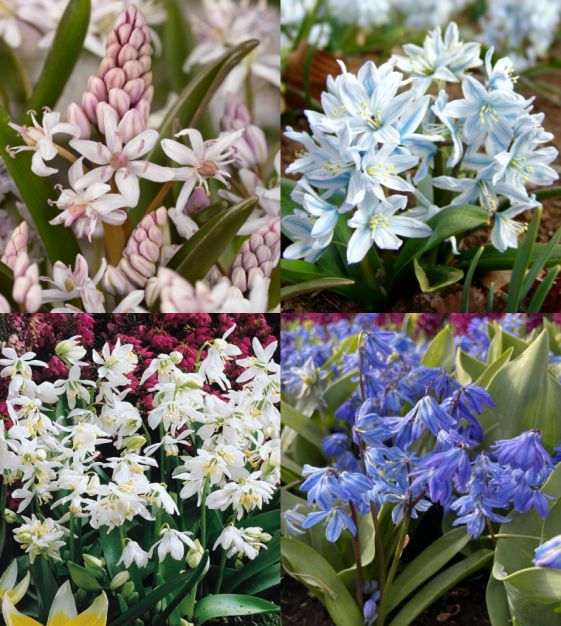-
- Discounted Collections
- Website Specials
- New for 2025!
- Tulips
- Narcissi
- Allium
- Anemone blanda
- Brodiaea
- Camassia
- Chionodoxa
- Corydalis
- Crocus
- Eranthis
- Eremurus
- Erythronium
- Fritillaria
- Galanthus
- Geranium
- Gladiolus
- Hyacinths
- Hyacinthoides
- Ipheion uniflorum
- Dutch Iris
- Rock Garden Iris
- Ixiolirion
- Leucojum aestivum
- Muscari
- Ornithogalum
- Oxalis
- Puschkinia
- Scilla
- Lilies
- Peonies
- Amaryllis
- Paperwhites
- Tender Bulbs
- Anemone Giants
- Tecolote Ranunculus
- Freesias
The Woodland Squill Mixture
Naturalizing Woodland Squill impart such magic and beauty to sun-dappled forests, rock gardens and garden borders. Our new blend includes equal parts of Scilla bifolia rosea, mischtschenkoana, siberica alba and siberica Spring Beauty. You’ll need about nine bulbs per square foot. (Square footage is determined multiplying the planting site’s length times its width.) In woodland settings, you can also scatter-plant the bulbs for a more natural look. Full to partial sunlight. Bloom time: April. Horticultural zones 3-8. Plant 5" deep and 4" to 6" apart. Height: 4” to 5”. (Scilla are also good for forcing: pot them up in mid-October, precool them at a consistent, dark 38° to 45°F for six to eight weeks with moderate watering. Bring them into the house~they will bloom about two to four weeks later.)
Scilla are The Art & Soul of Spring.
Scilla Horticultural Tips Stinze Plantings
Scilla are The Art & Soul of Spring.
Scilla Horticultural Tips Stinze Plantings
- Information
Scilla
For decades, perhaps generations, Hyacinthoides and Scilla have been classified and reclassified together as Scilla or Endymion, or apart, as they are today, as Hyacinthoides and Scilla. They are deer- and rodent-resistant, prefer a bit of light shade and naturalize readily in both woodland settings and display gardens, becoming increasingly more substantial and prolific over time. Economical for large woodland drifts or garden border swaths, you’ll be amazed over the transformative impact that these little bulbs have over time.
Scilla are The Art & Soul of Spring.
Scilla Horticultural Tips Stinze Plantings
For decades, perhaps generations, Hyacinthoides and Scilla have been classified and reclassified together as Scilla or Endymion, or apart, as they are today, as Hyacinthoides and Scilla. They are deer- and rodent-resistant, prefer a bit of light shade and naturalize readily in both woodland settings and display gardens, becoming increasingly more substantial and prolific over time. Economical for large woodland drifts or garden border swaths, you’ll be amazed over the transformative impact that these little bulbs have over time.
Scilla are The Art & Soul of Spring.
Scilla Horticultural Tips Stinze Plantings
Scilla
For decades, perhaps generations, Hyacinthoides and Scilla have been classified and reclassified together as Scilla or Endymion, or apart, as they are today, as Hyacinthoides and Scilla. They are deer- and rodent-resistant, prefer a bit of light shade and naturalize readily in both woodland settings and display gardens, becoming increasingly more substantial and prolific over time. Economical for large woodland drifts or garden border swaths, you’ll be amazed over the transformative impact that these little bulbs have over time.
Scilla are The Art & Soul of Spring.
Scilla Horticultural Tips Stinze Plantings
For decades, perhaps generations, Hyacinthoides and Scilla have been classified and reclassified together as Scilla or Endymion, or apart, as they are today, as Hyacinthoides and Scilla. They are deer- and rodent-resistant, prefer a bit of light shade and naturalize readily in both woodland settings and display gardens, becoming increasingly more substantial and prolific over time. Economical for large woodland drifts or garden border swaths, you’ll be amazed over the transformative impact that these little bulbs have over time.
Scilla are The Art & Soul of Spring.
Scilla Horticultural Tips Stinze Plantings





